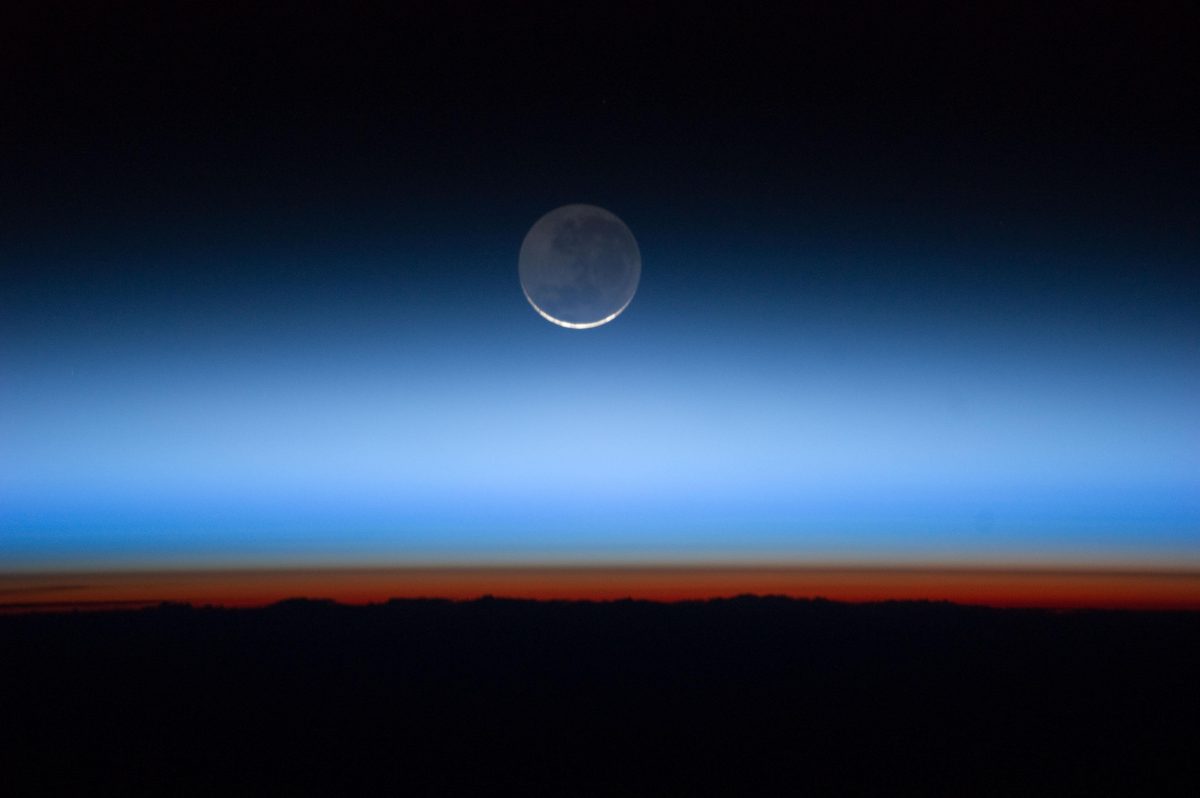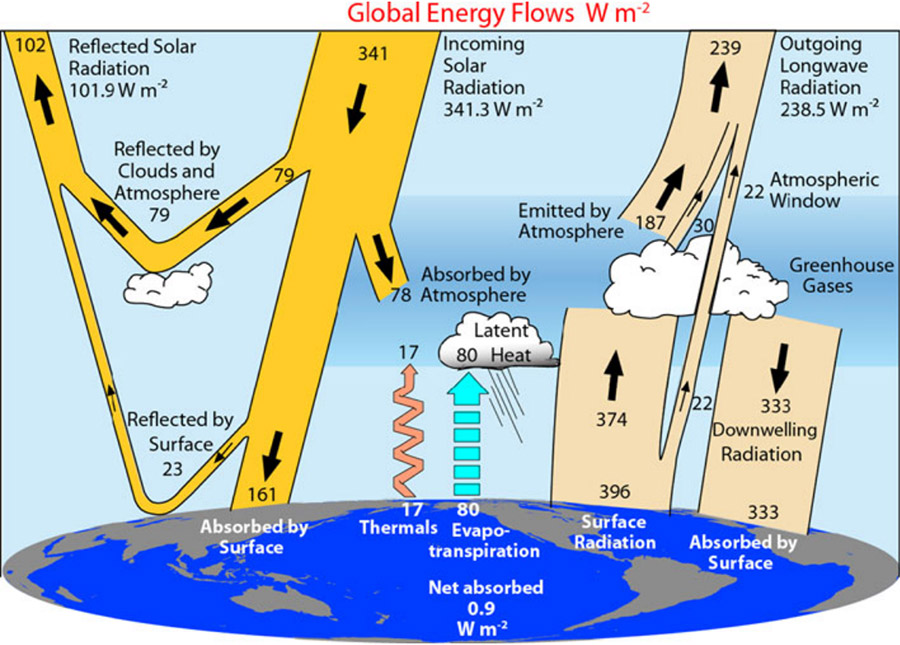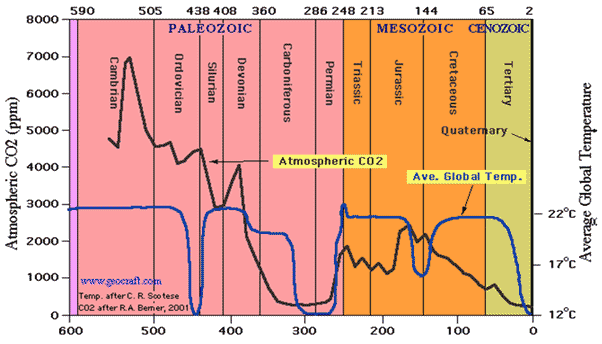Here's what real science says about the role of CO2 as Earth's preeminent climatic thermostat
Posted on Categories Discover Magazine

The relatively thin atmospheric cocoon that protects us from meteor impacts and radiation also makes for a habitable climate, thanks to the greenhouse gases it contains — carbon dioxide first and foremost. In this photograph captured by an astronaut aboard the International Space Station on July 31, 2011, the oblique angle reveals the atmosphere’s layers, along with a thin crescent Moon illuminated by the Sun from below the horizon of the Earth. (Source: NASA Earth Observatory)
Whenever I post something here at ImaGeo involving climate change, it’s a good bet that I’ll get a spectrum of critical responses in the comments section. These range from skepticism about the urgency of the problem to outright dismissal of humankind’s influence on climate through our emissions of greenhouse gases.
A recent post here about thawing permafrost releasing climate-warming carbon dioxide into the atmosphere was no exception. For the story, I reviewed dozens scientific research papers, and used information and quotations from two interviews. Based on that reporting, here’s what I wrote at the top of the story:
The coldest reaches of the Arctic on land were once thought to be at least temporarily shielded from a major — and worrisome — effect of a warming climate: widespread melting of permafrost. But a recent study suggests these northernmost Arctic areas are likely to thaw much sooner than expected. That’s concerning because melting permafrost releases climate-warming greenhouse gases.
As always, I expected skeptical pushback — but nothing as extreme as this:
As CO2 has had no noticeable effect on climate in 600 million years, until 15- 20 years ago, when carbon tax was invented, any alleged climatic effects can be ignored.
I took this to mean that a liberal scientific establishment invented the idea that carbon dioxide plays a role in Earth’s climate system to support raising taxes.
Never mind that relatively simple physics worked out in the 1800s, and since corroborated by experiments and observations, show that adding CO2 to the atmosphere should raise Earth’s average temperature.
I ordinarily ignore comments like the one I quote above. Discover is a science magazine, not a platform for political grandstanding. And it is especially not a platform for ideas that run counter to basic physics and more than a century of hard scientific work by generations of researchers.
This is not to say that I and the other writers and editors here at Discover view science as being infallible. Far from it. We recognize that as a human endeavor, science is prone to error born of vanity, preconceived notions, confirmation bias, a herd mentality, etc. Scientists know this better than anyone, so skepticism is one of their cardinal values. So is the recognition that even today’s most widely accepted theories may have to be modified or even replaced tomorrow if new evidence requires it.
Journalists are also supposed to be skeptical and self-critical. We should frequently ask ourselves things like, “How do I know this? Am I sure? Maybe I should check because I could be deceived by my preconceived notions.”
And so in this case, I thought it would be useful to delve deeper into what scientists know of the link between carbon dioxide and climate over the geologic timescale, and CO2’s overall role as a kind of thermostat for the planet.
I don’t pretend that what follows is a definitive primer on these issues. Not even close. But I thought it might be useful to share what I learned — if for no other reason that it might arm readers with some useful scientific information when they encounter people peddling politics in the name of science.
So, back to that original claim that “CO2 has had no noticeable effect on climate in 600 million years,” the commenter wrote this to support it:
My evidence for my comment, is climate history over 600 million years, during which time, when CO2 increased, global temperature decreased, for several million years, and when CO2 decreased, global temperature increased, also for several millions of years.
He also used a graph originally posted online by someone named Monte Hieb at this website. Hieb has changed the graph a number of times over the years. The following version is one that has been frequently picked up by people who deny the science on humankind’s impact on climate, including such well known figures as Christopher Monckton:
It purports to show that CO2 and climate really aren’t well linked.
When I sought more information about this graph, I landed first on a post at RealClimate by Gavin Schmidt, who heads NASA’s Goddard Institute for Space Studies. From his article, titled “Can we make better graphs of global temperature history?,” I learned that Hieb had hand drawn his temperature record based on the work of a scientist named Chris Scotese. And as Schmidt puts it:
Scotese is an expert in reconstructions of continental positions through time and in creating his ‘temperature reconstruction’ he is basically following an old-fashioned idea . . . that the planet has two long-term stable equilibria (‘warm’ or ‘cool’) which it has oscillated between over geologic history. This kind of heuristic reconstruction comes from the qualitative geological record which gives indications of glaciations and hothouses, but is not really adequate for quantitative reconstructions of global mean temperatures. Over the last few decades, much better geochemical proxy compilations with better dating have appeared . . . and the idea that there are only two long-term climate states has long fallen by the wayside
The “proxy” records Schmidt references are preserved physical characteristics of the environment that stand in for direct measurements — in this case, chemical fingerprints in the geological record of changing climatic conditions. (For more on proxy records, see this explainer.)
Based on Schmidt’s post, here is part of my response to the commenter claiming no link between CO2 and climate:
You are deluded by hubris — the idea that by reading one graph of suspect origin you know better than an entire scientific community consisting of literally thousands of researchers, operating over many decades and doing the actual hard work of science — and holding up their findings to rigorous review by expert peers.
I went on to say this:
. . . your alleged “evidence” is a graph, in part hand-drawn, posted to a website that hasn’t been updated in six years by an obscure person with no discernible expertise in this area, and based on the work of a scientist who is not an expert in paleo temperature reconstructions and whose ideas were long ago supplanted by better work based on actual physical proxy records.
I then pointed him toward an example of real researchers doing the truly complex and hard work of science — a peer-reviewed paper titled “CO2 as a primary driver of Phanerozoic climate”.
In their paper, the team of five scientists analyzed a wealth of different data to examine the role of CO2 in climate over the past 540 million years. Their conclusions are nuanced — which is to be expected for a system as complex as global climate, and especially when looking at it over such long time periods. But here is the most relevant fundamental finding:
Here we review the geologic records of CO2 and glaciations and find that CO2 was low (<500 ppm) during periods of long-lived and widespread continental glaciations and high (>1000 ppm) during other, warmer periods.
Other scientists have addressed particular details of the geologic record. These include a period of glaciation that occurred during late Ordovician Period. Climate change dismissives say it happened despite sky high concentrations of climate-warming carbon dioxide in the atmosphere 440 million years ago. This, they claim, is proof that CO2 plays less of a role, or even no role, in determining Earth’s climate.
In supporting this claim they use a geochemical model called “GEOCARB” that provides estimates of CO2 concentrations through geologic time. But the critics fail to mention that the data included in the GEOCARB model come in very long time steps of 10 million years. With this in mind, the creators of GEOCARB explicitly warned that their model cannot discern changes in CO2 occurring over periods less than 10 million years long — including shorter-term drops of the kind that scientists have shown likely occurred during the late Ordovician glaciation.
“Thus, exact values of CO2 . . . should not be taken literally and are always susceptible to modification,” GEOCARB’s creators said.
Yet climate dismissives do just that. And they ignore copious evidence gathered by scientists supporting lower CO2 levels in the atmosphere during that period. For example, a 2009 paper in the journal Geology came to the following conclusion, as described by Phil Berardelli in a story in Science:
The rise of the Appalachians plunged Earth into an ice age so severe that it drove nearly two-thirds of all living species extinct. That’s the conclusion of a new study, which finds that the mountains’ rocks absorbed enough greenhouse gas to freeze the planet.
For more details about the Ordovician glaciation and related issues, the website Skeptical Science has an excellent overview. And for a broad overview of CO2’s role in Earth’s climate over geological history, check out this lecture by Richard Alley, a renowned Penn State geoscientist:
Commenters on my blog also often claim that since the concentration of CO2 in the atmosphere is so low compared to that of water vapor, also a greenhouse gas, it could not possibly play the role of a thermostat. But here, too, rigorous research shows otherwise.
For example, a team of four NASA scientists led by Andrew Lacis and including Gavin Schmidt, found this: “Ample physical evidence shows that carbon dioxide (CO2) is the single most important climate-relevant greenhouse gas in Earth’s atmosphere.”
Yes, water vapor and clouds are the major contributors to Earth’s overall greenhouse effect. And, in fact, a companion study led by Schmidt showed that water vapor and clouds together account for 75 percent, with CO2 coming in at 20 percent, and other non-condensing greenhouse gases making up the rest.
So given that CO2 accounts for just a fifth of Earth’s overall greenhouse effect, what supports the claim that it nevertheless is the most important greenhouse gas?
The answer involves different characteristics of greenhouse gases. When the atmosphere cools enough, water vapor condenses and rains out. By contrast, carbon dioxide, methane and other greenhouse gases do not — they are non-condensing.
The researchers found that without these non-condensing greenhouse gases — CO2 foremost among them — there would be nothing to prevent the atmosphere from cooling enough to cause water vapor to rain out. And since it is such a potent greenhouse gas, if water vapor were to rain out, the result would be very dramatic cooling. In this way, CO2 may not be as potent a greenhouse gas as water vapor, but it is actually more important.
“Without the radiative forcing supplied by CO2 and the other noncondensing greenhouse gases, the terrestrial greenhouse would collapse, plunging the global climate into an icebound Earth state,” the authors of the first study concluded.
Just how much does carbon dioxide contribute? The second study led by Gavin Schmidt concluded that the CO2 in our atmosphere is itself is responsible for 80 percent of the radiative forcing that sustains Earth’s greenhouse effect.

Scientists have worked out the fine details of how energy flows through Earth’s atmosphere, as seen in this diagram. It shows how energy contained in sunlight warms our planet, and how this energy becomes temporarily trapped as it flows away from Earth’s surface as longwave infrared radiation. This energy trap produces the greenhouse effect, the main driver of global warming. (Source: Kevin Trenberth, John Fasullo and Jeff Kiehl via UCAR)
This brings me to another claim made by some commenters here at ImaGeo. Climate records show that global temperatures drop before CO2 does as Earth enters an ice age, and visa versa too: Temperatures rise before CO2 as we come out of an ice age. So once again, CO2 cannot be the most important factor.
Scientists have actually long known that something something other than CO2 sets things in motion when Earth enters and emerges from ice ages: shifts in solar radiation reaching Earth due to variations in the Earth’s orientation to the Sun. (These are known as Milankovitch cycles). Then other natural feedbacks kick in — most especially changes in carbon dioxide.
Scientists haven’t fully teased out all of the details yet. But in general, the picture looks like this:
As Earth starts to warm at the end of an ice age due to increased solar radiation reaching Earth, ice sheets and snow begin to contract. These surfaces are very reflective. So as they shrink, less sunlight is reflected back into space. This helps to enhance the warming. The warming causes ocean waters to give up CO2 — because CO2 is less soluble in warmer water. This strongly enhances the warming, which reduces the ice and snow, which causes more warming, which increases the CO2, leading to even more warming.
The bottom line is that a change in the amount of solar energy reaching Earth may get things going, but it’s CO2 that plays the dominant role.
This general picture leaves out some important details, such as the role of fresh water flowing into the oceans as ice sheets melt. A 2012 study led by Jeremy Shakun, now a Boston College climatologist, examined some of these details. Skeptical Science posted an excellent explainer about the results here. But the upshot of the study was this: “While the orbital cycles triggered the initial warming, overall, more than 90% of the glacial-interglacial warming occured after that atmospheric CO2 increase.”
I’ll finish with one recent piece of research in which a team of five scientists examined the role of greenhouse gases in temperature anomalies, including the overall warming trend, since the onset of the industrial revolution.
Here, too, commenters on this blog often claim that since recent periods in Earth’s past were almost as warm as it is now, we can’t know for sure that the CO2 we’ve added to the atmosphere is responsible for the observed recent warming.
But in their paper, published in the journal Scientific Reports, the scientists confirmed that our emissions of greenhouse gases, “especially CO2, are the main causal drivers of the recent warming.”
Earth’s climate is clearly an incredibly complex system. And climate scientists have never contended that they’ve understood all the details, or that their current understanding isn’t subject to revision when new evidence comes along. This is why they continue to do their research – to improve our understanding of how one of Earth’s key life support systems works.
They’ve also never contended that CO2 is the sole factor driving climate changes over geologic history. As we’ve seen, however, it plays a key role: Without the CO2 thermostat, Earth would likely be a proverbial snowball.
And now, we humans have turned the thermostat up, with predictable results that we’re already observing — such as changes to permafrost in the Arctic that got me going on this post to begin with.
